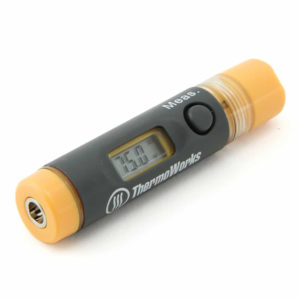
IP67 Rated Waterproof IR ThermoWorks Thermometer – $9.50, Save 50%! via Inventory Reduction Sale
Pocket Infrared Thermometer (IR-POCKET) by ThermoWorks
From the product description, check product page for current description, price and availability:
The IR Pocket Infrared Thermometer is a professional infrared thermometer in pocket-sized package. With your IR Pocket Infrared you can measure surface temperatures around the house, cabin, grill, garage, and in the kitchen. Simply point your IR Pocket Infrared and shoot with no extra confusing buttons to learn. The IR Pocket Infrared is pre-set to an emissivity that measures most surfaces.
- Measures surface temperature
- IP67 Waterproof
- Pocket sized
- Easy to use, point-and-shoot simplicity
- Range to 230°F (110°C)
- Switchable °C to °F
Since this is no touch, you can check the temp of yeast washing and yeast rehydration water and your starter wort without the risk of infection. I find mine particularly useful for rehydrating yeast.
Infrared thermometers should not be considered a direct replacement for a conventional thermometer. A quality IR thermometer will give you a close approximation of surface temperatures. Note that steam seems to throw off readings. Uses include: Contained yeast rehydration water, chilled wort or starter temperature, kegerator, fermenter or fermentation area and beer tasting samples. If you’re looking for a great conventional thermometer consider Thermapen ONE – Hands on Review
As of this posting, ThermoWorks is marking this thermometer down a whopping 50% to just $9.50 via their annual inventory reduction sale. Check ThermoWorks for up to the minute price and availability
Pocket Infrared Thermometer (IR-POCKET)
pinnedThis post may contain affiliate links. We may make a commission when you use our links. This will never cost you extra. Thank you for supporting Homebrew Finds!
greatdeals


Sounds like an interesting gadget! You say, “you can check the temp of yeast washing and yeast rehydration water and your starter wort without the risk of infection. I find mine particularly useful for rehydrating yeast.
Q: Is there a difference between surface temp and internal (further down) temp of these liquids; and could that make a significant difference? How could this be used to measure the temp of fermenting beer in a primary or secondary fermenter?
This could certainly be the case. With the example of water for yeast rehydration you can mitigate that by swirling the water.